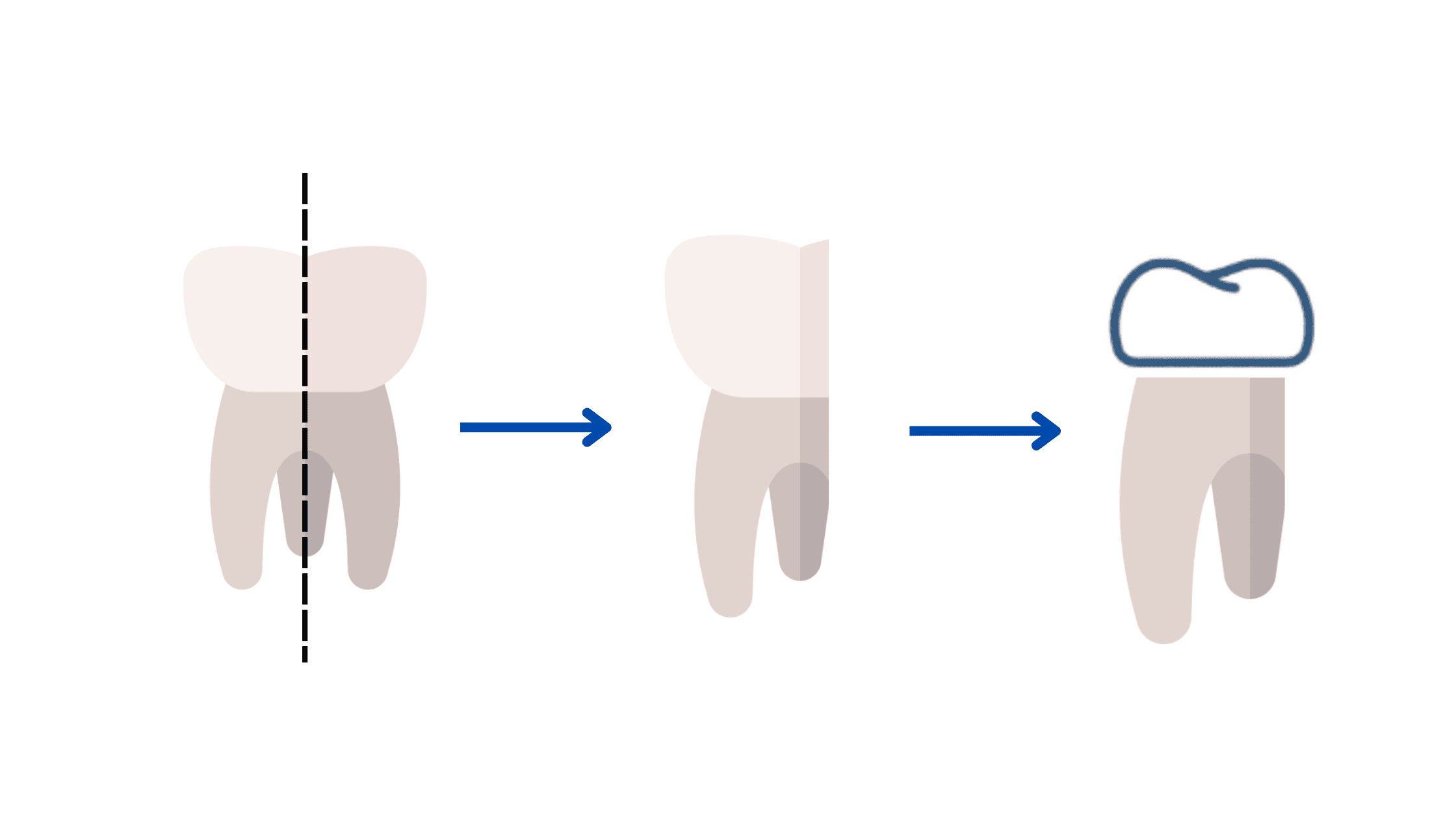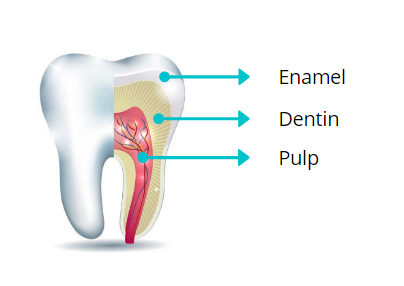Tooth split in half vertically: All you need to know
 Tooth fractures, especially vertical ones, can affect any tooth in your mouth. They can be limited to the top of the tooth (the crown), the roots, or both.
Tooth fractures, especially vertical ones, can affect any tooth in your mouth. They can be limited to the top of the tooth (the crown), the roots, or both.
They are becoming more and more common. This is because today people are keeping their teeth longer. The more time passes, the more stress is put on the teeth and the higher the risk of fractures.
Treatment depends on the extent and severity of the injury. So the sooner you act, the better the chance of saving your tooth.
Table of content
- What is a split tooth in half?
- How is a split tooth in half diagnosed?
- Symptoms and potential complications of a split tooth
- Don't confuse split teeth with craze lines
- What causes the tooth to split in half?
- Treatment options for a split tooth (with and without extraction)
- Other types of dental fractures
- How to prevent dental fractures?
What is a split tooth in half?
A split tooth in half is when the fracture starts at the chewing surface and extends to the roots below the gum line.The teeth most likely to be affected are the molars (back teeth), as they receive the most chewing pressure.
It usually starts with a superficial fracture of the crown that has progressed deep into the root area, dividing the tooth into two segments. It can also be the result of sudden, severe trauma.
How is a split tooth in half diagnosed?
Your dentist will first assess the extent and severity of the fracture.In the early stages, the fracture line can be challenging to detect. Sometimes only some symptoms, such as discomfort or pain when chewing, can indicate the presence of such lesions.
Over time, the fracture line may become discolored, revealing a crack that runs vertically across the height of the tooth and extends below the gum line. If the fracture has split your tooth in half, you may notice that it has become loose and tends to come out.
Your dentist may use different tools and techniques to make an accurate diagnosis, including:
- Ask questions: Your dentist will ask if you feel pain when you press on the tooth or eat hot or cold food. These are some of the first signs.
- Do a visual test: He will look for the fracture line to assess its extent and direction on your tooth.
- Remove the restoration: This is the safest way to assess the fracture line of a cracked tooth. If your tooth is filled, your dentist may suggest removing it for a better assessment.
- Use a microscope: This tool allows the dentist to take a closer look at what is happening inside a chipped tooth.
- Periodontal probing: Your dentist will use an instrument to examine the tissue around the fracture and assess the depth of the damage.
Symptoms and potential complications of a split tooth
If a tooth is broken, bacteria can enter the tooth through the fracture line and affect the nerves. At first, you may feel pain when you eat hot or cold foods. But later, an infection may develop along with severe pain.
Bacteria can also enter the tissue surrounding the tooth and cause the same symptoms. Your gums may become red, swollen, and inflamed. In an advanced stage, an abscess may appear.
However, if there is no pain, it does not mean that the tooth is safe. It may just be the first stage of a fracture that has not yet reached the pulp. The tooth may also be dead or have had a root canal. In this case, the tooth will not react, but the surrounding tissue may still be affected and cause pain later.
Don't confuse split teeth with craze lines
Craze lines are another type of injury that can give the impression that the tooth has split. It appears as a long, tiny defect that runs from the top of the tooth to the gum line. However, unlike split teeth, craze lines are limited to the enamel, the outermost tooth layer, and don't extend to the roots.Craze lines are more common in older people and can affect the front and back teeth. The risk increases even more if you have a dental filling or you clench or grind your teeth.
Because the enamel is not innervated, craze lines are not painful. Usually, they are not something to worry about and do not require treatment.
What causes the tooth to split in half?
Factors that can cause the tooth to split in half include:- Excessive pressure on the tooth: Excessive pressure on the tooth can weaken it and make it more susceptible to fracture. Examples include grinding and clenching teeth, and biting down on hard objects such as ice cubes or grains.
- A large filling: A large, ill-fitting filling can also weaken the tooth, increasing the risk of fracture. Your dentist may suggest a crown to restore the tooth and protect it from further damage.
- Tooth decay: It is one of the most common diseases in the world. It eats away at the hard layers of the tooth, including the enamel and dentin. If left untreated, it can affect a large portion of the tooth, making it more susceptible to cracking.
- Trauma: This could be due to an accident or a severe blow to your teeth. Trauma can damage not only the tooth but also the tissues around it, including bone, ligaments and gums.
Treatment options for a split tooth
Vertical fractures are the most difficult to repair. Often, the tooth will need to be removed.However, if the fracture is not too deep to the roots, it can probably be saved. In this case, treatment often consists of removing the loose fragment and restoring the remaining tooth with a dental crown after root canal treatment.
Sometimes, a crown lengthening procedure may be required first. It increases the height of the damaged tooth for proper and long-lasting restoration.
Treatment options to restore a split tooth in half include:
1. Treatment without extraction
1. First Option:
- Removing the loose fragment;
- Root canal treatment;
- Tooth restoration
2. Second Option:
- Root canal treatment;
- Crown lengthening;
- Tooth restoration
Once the height of the visible crown is sufficient, it can be properly restored.
3. Third Option: Tooth hemisection
Sometimes the fracture is too deep in the roots. In this case, an extraction is necessary.However, in the back teeth with multiple roots, a tooth portion can be saved by extracting half of the damaged tooth. This procedure is known as tooth hemisection. The remaining tooth is then restored with a crown after root canal treatment.

2. Treatment with extraction
If the tooth cannot be restored, it may need to be removed. There are several treatment options to replace the missing tooth. These include:Implant
The implant is the best option to replace a missing tooth because it simulates the role and function of natural teeth. It consists of surgically placing a metal post in the jawbone, which will serve as a support for a crown.Bridge
A dental bridge is a false tooth (called a pontic) held in place by the teeth that line the space.Dentures
Dentures (false teeth) are synthetic replacements for missing natural teeth. This option is indicated if you have several missing teeth and cannot afford implants.Other types of dental fractures
In addition to a split tooth in half, other types of fractures can occur. These include:- Fractured cusp: This occurs when a small piece of the tooth breaks off without going beyond the gum line. A fractured cusp is the easiest to spot. It is usually caused by a weakening of the tooth due to wear, decay, or extensive filling.
- Cracked tooth syndrome: The fracture extends beyond the gum line without separating the tooth into two fragments. It often reaches the pulp, causing severe pain. Cracked tooth syndrome can be harder to detect and needs to be checked by your dentist.
- Vertical root fracture: Unlike other types of tooth fracture, a vertical root fracture starts at the root and moves towards the crown. It usually occurs in teeth with root canal treatment. Root fractures can cause severe pain when chewing and may be associated with an abscess.
How to prevent dental fractures?
Preventive measures aim to strengthen your teeth to improve their resistance.The most common causes of a split tooth in half are large fillings and excessive stress on the teeth.
Be sure to practice good dental hygiene by brushing your teeth twice a day with fluoridated toothpaste. Also, remember to floss daily and visit your dentist every six months for check-ups and professional dental cleaning.
Avoid chewing on hard objects, especially if you have a crown or filling. If you grind or clench your teeth, consider wearing a mouth guard at night.
Split teeth in half can be associated with a gum abscess. If you notice any swelling, redness, or pus discharge in the fracture area, or feel throbbing pain, make an appointment as soon as possible with your dentist.
In the meantime, you can take OTC pain medications to relieve the pain, rinse with salt water and baking soda to clean your mouth and reduce the inflammation, and place a cold compress in the swollen area.
Finally, remember that dental fractures are a progressive condition. Delaying treatment means putting your mouth at even greater risk.
- Endodontic Diagnosis, Pathology, and Treatment Planning, Bobby Patel
- An interdisciplinary approach to treat crown-root-fractured tooth https://www.ncbi.nlm.nih.gov/pmc/articles/PMC3821233/
- Enamel craze lines https://pubmed.ncbi.nlm.nih.gov/25233570/
